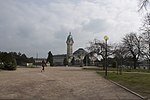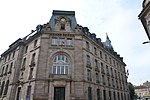Zénith Limoges Métropole
21st-century architecture in FranceBernard Tschumi buildingsBuildings and structures in LimogesConcert halls in FranceIndoor arenas in France ... and 3 more
Music venues completed in 2007Music venues in FranceTourist attractions in Haute-Vienne

The Zénith Limoges Métropole (also known as the Concert Hall in Limoges) is an indoor amphitheater designed by famous architect Bernard Tschumi. This building is located in a wooded area on the outskirts of the city of Limoges in central France. The concert hall in Limoges can accommodate up to 6,000 spectators.
Excerpt from the Wikipedia article Zénith Limoges Métropole (License: CC BY-SA 3.0, Authors, Images).Zénith Limoges Métropole
Avenue Jean Monnet, Limoges Uzurat
Geographical coordinates (GPS) Address External links Nearby Places Show on map
Geographical coordinates (GPS)
| Latitude | Longitude |
|---|---|
| N 45.862296 ° | E 1.279328 ° |
Address
Zénith
Avenue Jean Monnet
87068 Limoges, Uzurat
Nouvelle-Aquitaine, France
Open on Google Maps







